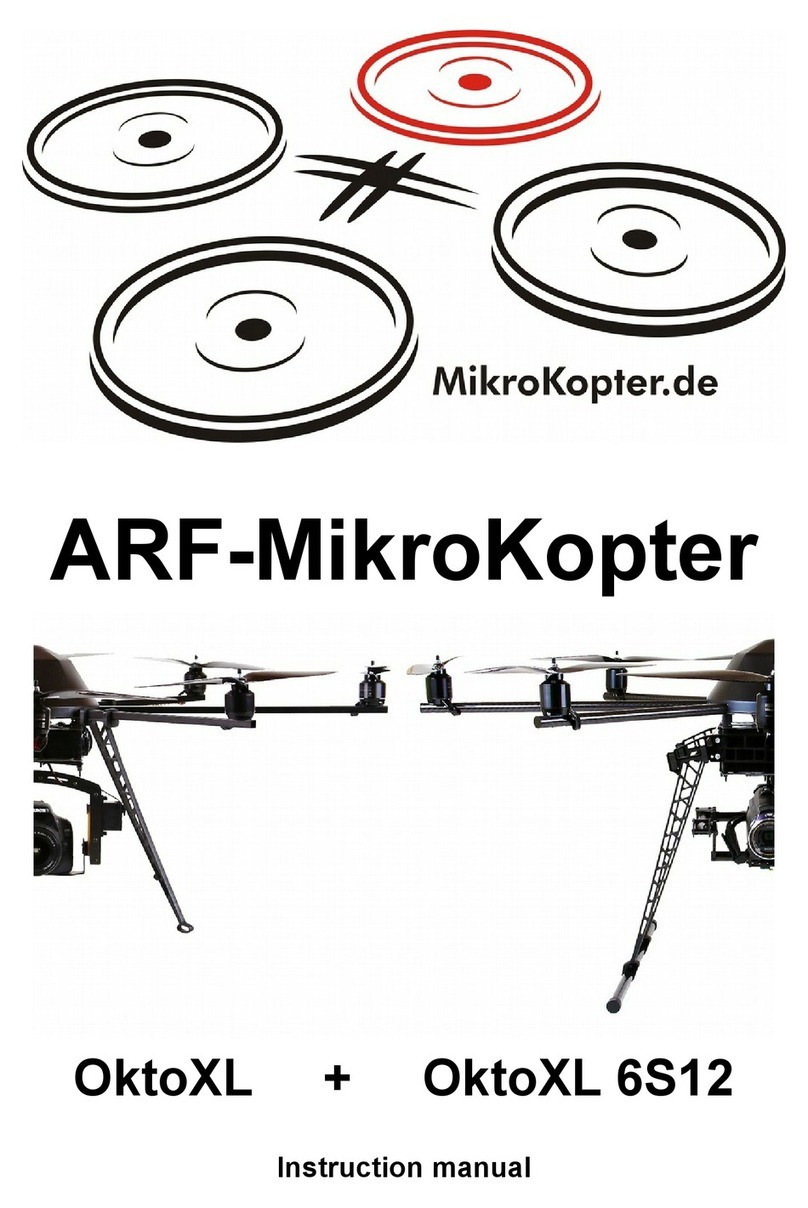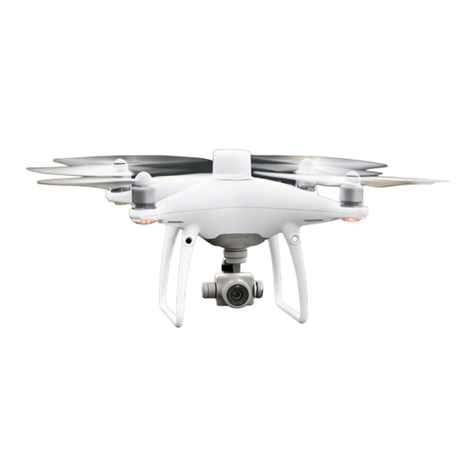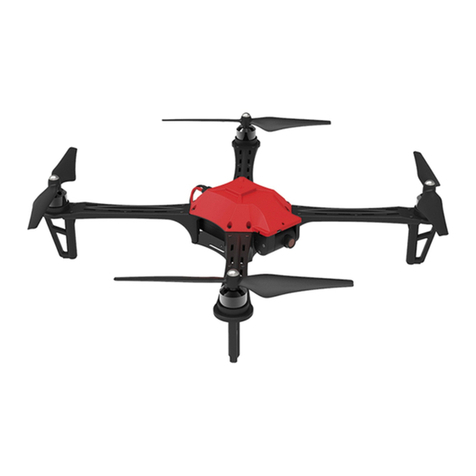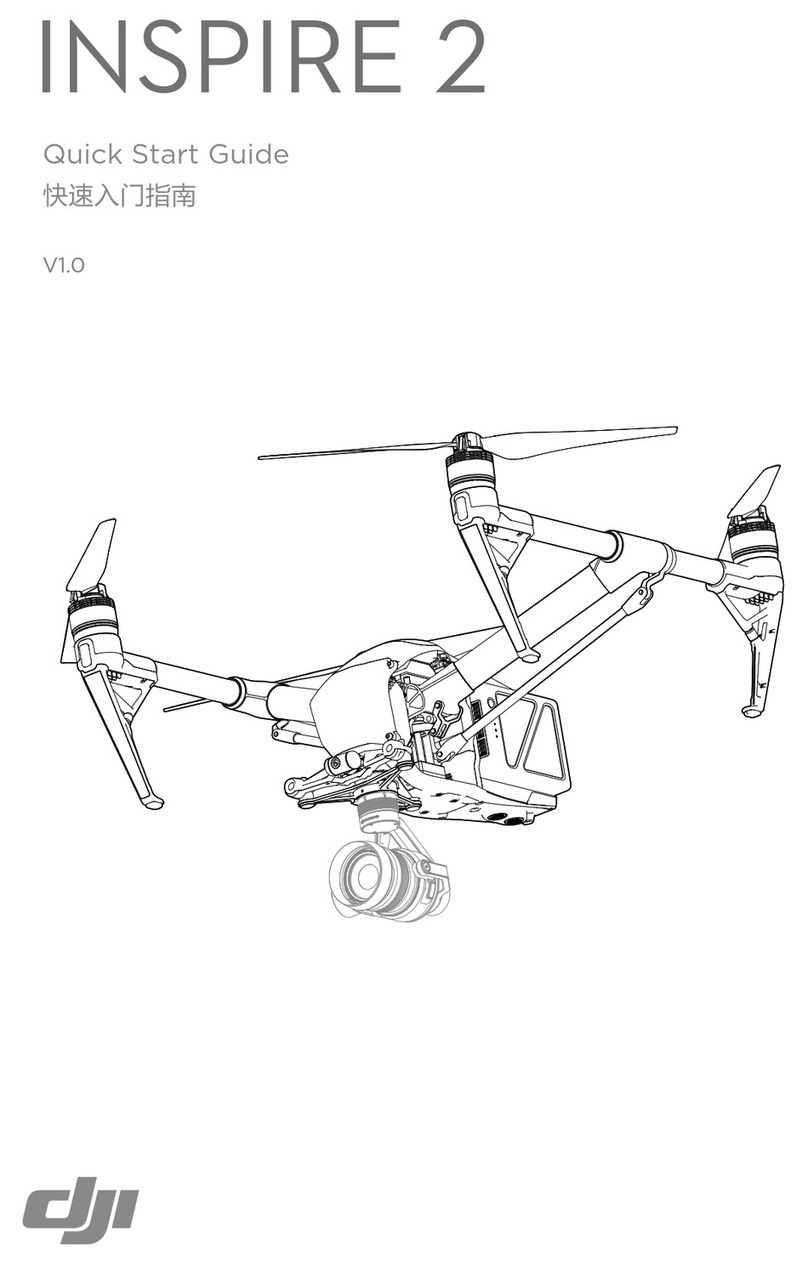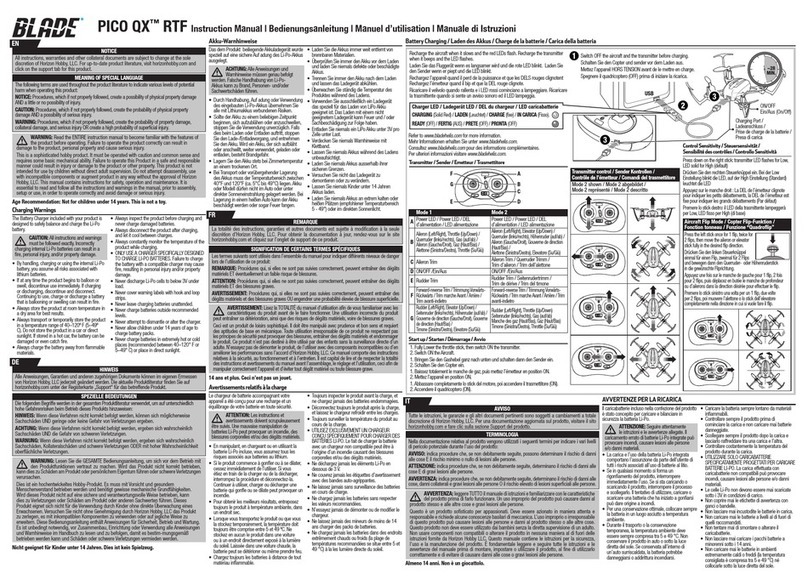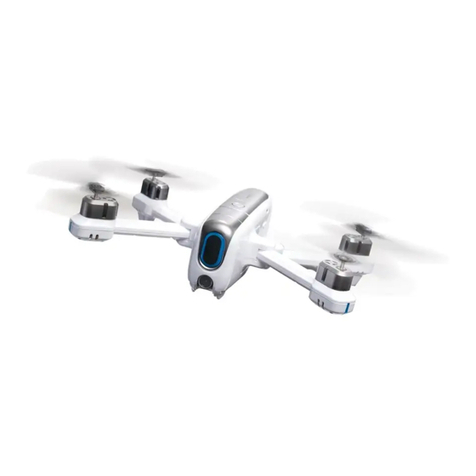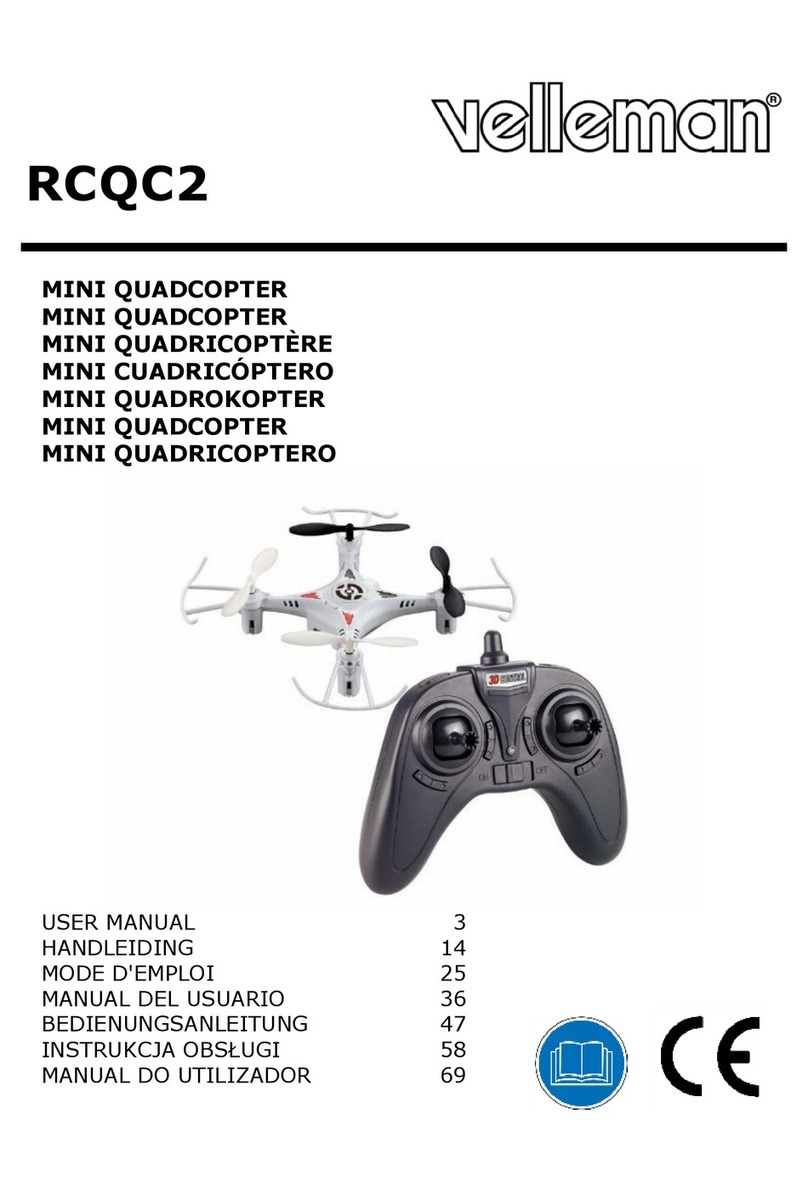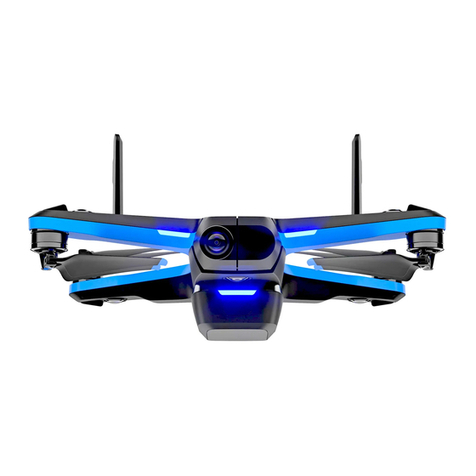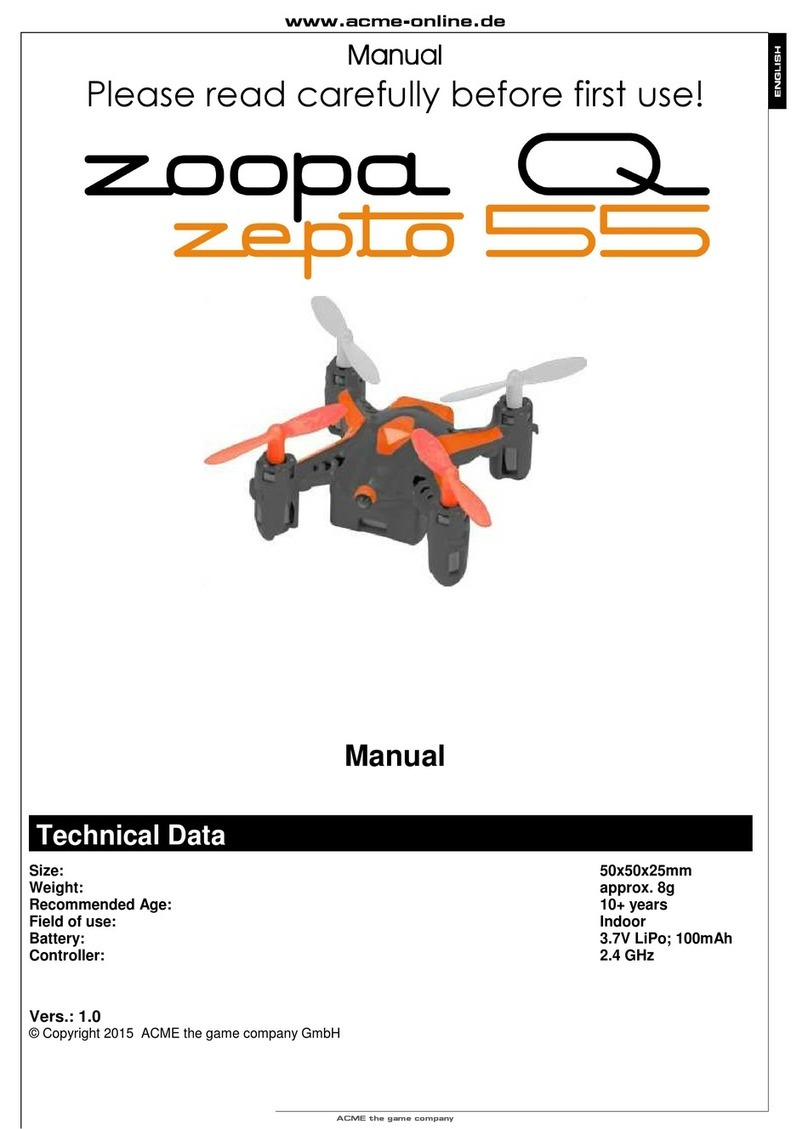MikroKopter ARF OktoXL User manual

ARF-MikroKopter
OktoXL
Instruction manual


Index
Introduction..................................................................................................................................................................... 1
Sym ols........................................................................................................................................................................... 1
Intended Use................................................................................................................................................................... 1
Safety............................................................................................................................................................................... 2
General....................................................................................................................................................................... 2
Functions of the ARF MikroKopter ..............................................................................................................................3
Control........................................................................................................................................................................ 4
Before each flight........................................................................................................................................................ 4
Flight simulator............................................................................................................................................................... 5
Battery (LiPo) – General information............................................................................................................................6
Safety rules for LiPos.................................................................................................................................................. 6
Charge LiPo ............................................................................................................................................................... 7
Using BID ( obbe)...................................................................................................................................................... 7
Overall View.................................................................................................................................................................... 8
Connections at the ARF-MikroKopter........................................................................................................................... 9
The bottom side.......................................................................................................................................................... 9
Final assem ly.............................................................................................................................................................. 11
Mounting the battery holder......................................................................................................................................11
Assembly of the landing gear.................................................................................................................................... 13
Connecting the receiver............................................................................................................................................ 14
Propeller assembly................................................................................................................................................... 15
Insert the battery ...................................................................................................................................................... 16
Checking the functions / First-time start....................................................................................................................17
Channel assignment................................................................................................................................................. 17
First Test flight.............................................................................................................................................................. 18
Settings.......................................................................................................................................................................... 21
Settings..................................................................................................................................................................... 21
Step 1: Setup MK-USB ........................................................................................................................................... 21
Step 2: Connect MK-USB to the A F-MikroKopter ..................................................................................................22
Step 3: Download MikroKopter-Tool......................................................................................................................... 22
Step 4: First Start MikroKopter-Tool..........................................................................................................................22
Step 5: Connect battery with the A F-MikroKopter .................................................................................................23
Step 6: Checking the channel assignment................................................................................................................24
Step 7: Testing the camera mount............................................................................................................................25
Step 8: Camera trigger.............................................................................................................................................. 26
Step 9: Test motors individually................................................................................................................................ 27
Step 10: Test Gyroscopes......................................................................................................................................... 27
Cali ration..................................................................................................................................................................... 28
Acceleration Sensor (ACC).......................................................................................................................................28
Gyroscopes (Gyros) ................................................................................................................................................. 29
Compass................................................................................................................................................................... 29
Functions / Flight modes............................................................................................................................................. 31
The functions............................................................................................................................................................ 31
Free flight............................................................................................................................................................ 31
Height regulation................................................................................................................................................. 31
GPS-Functions.................................................................................................................................................... 32
Teachable CareFree............................................................................................................................................ 33
FailSafe............................................................................................................................................................... 35
WayPoint Flight............................................................................................................................................................. 36
Acoustic signals – LED displays................................................................................................................................. 38
Installation of the optional accessories..................................................................................................................... 39
Transmitter/ eceiver MX-20 / MC-20 / MC-32 ........................................................................................................39
Transmitter assignment: Graupner MX-20 .........................................................................................................40
Transmitter assignment: Graupner MC-20 ......................................................................................................... 41
Transmitter assignment: Graupner MC-32.......................................................................................................... 42
Mounting the camera mount..................................................................................................................................... 43
Camera trigger - Shuttercable................................................................................................................................... 44
Camera trigger – I -Ctrl / LANC...............................................................................................................................45
Installation of the video transmitter........................................................................................................................... 46
Connection Bluetooth-Set......................................................................................................................................... 47

Maintenance.................................................................................................................................................................. 48
Technical Data............................................................................................................................................................... 49
Delivery ......................................................................................................................................................................... 50
License.......................................................................................................................................................................... 50
Trou leshooting............................................................................................................................................................ 52
Fehlermeldungen (Error Codes).................................................................................................................................. 53
Disposal......................................................................................................................................................................... 55
General..................................................................................................................................................................... 55
Batteries.................................................................................................................................................................... 55
Impressum..................................................................................................................................................................... 55

Introduction
Dear Valued Customer,
thank you for purchasing our product..
This manual is part of the product. It will provide you important information regarding the operation and handling. To
ensure a safe operation please read this instruction manual carefully before using.
Please keep this manual handy at all times as a reference!
All company names and products are trademarks of their respective owners. All rights reserved.
Sym ols
This symbol alerts the reader to important points, such as hazards during operation
and handling.
The "Info-Arrow" shows locations with additional tips and hints.
Intended Use
The A F-MikroKopter is a model aircraft. An appropriate liability insurance is mandatory for operation. Please check your
insurance cover before using !
You as a user / pilot are responsible for a safe operation and correct function of the model !
The product is not a toy and it is not suitable for children under 14 years.
It is not allowed to make any unauthorized changes or modifications on the ARF-MikroKopter.
Operation is allowed only with the A F- MikroKopter approved modules, batteries and the original software.
Please follow all safety instructions in this manual. It contains important information about using the
product.
HiSystems GmbH Page 1
!
info
info
!

Safety
General
The ARF-MikroKopter (A F = Almost Ready to Fly) is a pre-assembled, pre-set and tested model aircraft.
Among those connections and/or adjustment work, a proper execution must be ensured.
No liability will be assumed for damage caused by not following instructions in this manual. Improper
connection and adjustment will also void the warranty.
Normal wear, crash damage or consequential damage are also excluded from the warranty.
–Those at the A F-MikroKopter assembled motors can cause a noise during operation and also
with an increased use.
–Those at the A F-MikroKopter used batteries will lose power with an increased use.
–Plastic propellers can become brittle / fragile through time and by sun exposure.
Please o serve the following notes:
•The pilot must be able to fly the A F MikroKopter in any situation without aids, such as the GPS system.
•Please note the information in the manual about your charger and transmitter.
•Do not switch off the transmitter while the copter is ON and the propellers turn.
•Model aircrafts can cause significant property damage and / or personal damage with improper handling.
•Do not touch a moving propeller. This can cause severe injuries.
•Never catch the Kopter out of the air! This may also lead to significant injury.
•Never turn the transmitter off during the flight. The Kopter can crash and can cause considerable damage.
•Leave the transmitter switched on while the A F-MikroKopter is operating.
•When starting, landing and flying make sure a sufficient large distance away from people, animals and objects
is ensured.
•Make sure the Kopter can not take off unintentionally when making adjustments. If necessary remove the
propellers for your own safety (such as during an engine test).
•Do not expose the Kopter to rain, moisture, excessive heat, cold or vibration.
•Do not control an A F-MikroKopter if you are under the influence of drugs or alcohol.
•Check the tightness of all connectors and screws as well as the mechanical integrity of the ARF-MikroKopter
before each start / flight.
•Never start if you have discovered a damage to the ARF-MikroKopter or to the transmitter / receiver.
•Fly with your ARF-MikroKopter always in sight. So you are able to respond quickly if a fault occurs by external
influences.
Page 2 HiSystems GmbH
!
info
info

Functions of the ARF MikroKopter
The A F MikroKopter comes with the GPS-System. You can use many additional functions with this GPS-System.
Functions of the ARF-MikroKopter:
•Highly versatile. For example Photo / Video flight, action shots, inspection / maintenance flights, surveys,
documentations, and much more.
•Easy to fly with automatic attitude stabilization (gyro and ACC support)
•edundancy by 8 propellers
•Secure fly further and be able to land even if one engine / propeller fails
•Fly securely at high wind strengths
•All functions are easy to use with the transmitter
•Safely carry payloads of up to 2500g or >5.5 lbs (e.g. SL camera, thermal imaging camera, etc.)
•Automatic alignment of a connected camera mount
•Additional control of the camera mount via the transmitter
•Camera trigger via the transmitter (optionale Shutterkabel, I -Ctrl oder LANC-Ctrl required)
•Start and Stop of a camcorder (optional I -Ctrl or LANC-Ctrl required)
•Live view from camera on the ground (optional Videos transmitter/-receiver is needed)
•Automatic “AltitudeHold” during flight
•Automatic “PositionHold” during flight
•Automatic “ComingHome” to the start point
•Automatic „FailSafe“ if signal lost
•Wireless data transmission can be connected
•Display of telemetry data with all important data like battery power, flight time, and more.
•See the current position of the Kopter in a map (MikroKopter-Tool on a Laptop required)
•Display of telemetry data in the “OSD” of the MikroKopter-Tool
•(optional Wi.232 or Bluetooth and a Laptop required)
•Place up to 200 Waypoints and/or POI (point of interest) on a map
•Fly waypoints and POI automatically
•Automatic alignment of a camera during a waypoint flight
•Can follow a „FollowMe“ transmitter automatically
•and much more
HiSystems GmbH Page 3

Control
An ARF-MikroKopter is easy to fly. But it takes practice and time to be able to control the Kopter safely. The pilot must
also be able to fly the Kopter in any situation without aids such as the GPS-System.
The Kopter is controlled by a C-transmitter. The Throttle, Yaw,
oll and Nick functions can be controlled by the sticks.
•Throttle
◦Controls the speed of the motors (up/down)
•Yaw
◦Turns the Kopter around
•Nick
◦Flies forward or back
•Roll
◦Flies left or right
(Example: Mode2)
Ideally the A F-MikroKopter can stay on position with no wind.
Info: Please leave the trim of the transmitter in middle position (off)
Via the switches, buttons and potentiometer of the transmitter further functions
like e.g. the automatic hold of the actual position (PositionHold), an automatic
back-flight to the start point (ComingHome) or non-directional flying (CareFree)
can be used.
For this purpose the mounted GPS-System and the compass-sensor is used. The
GPS system consists of the MK-GPS and NaviCtrl. The compass sensor is
installed on the NaviCtrl.
The functions are further described in „Functions / Flight modes“.
Before each flight
Check the Kopter always for:
•Damage to the frame, cables, motors, propellers and electronics
•Tightness of the rigger, motors and propellers
•Functions of the motors
•Tightness of all screws (Motors, igger etc.)
•Loaded and not damaged batteries (ARF-MikroKopter and transmitter)
The order of switching on / off the ARF-MikroKopter and the transmitter:
Switch on (before the flight):
1. All switches on the transmitter put into the default „OFF“.
2. Switch on the C-Control (if necessary choose the right model memory).
3. Bring the trim of the control-sticks into the middle position.
4. Connect the ARF-MikroKopter to the battery (LiPo).
Switch off (after the flight):
1. Switch off the motors.
2. Disconnect battery (LiPo) from the ARF-MikroKopter.
3. Switch off the transmitter.
(See also „Maintenance“ Pg. 48)
Page 4 HiSystems GmbH

Flight simulator
To get familiar with the controls we recommend practicing with the AeroSIM C – Flight simulator. In this PC-Program
various MikroKopter models can be flown like in reality. The same transmitter can be used, which is later also used for
the control of the ARF-MikroKopter.
With different training programs in this simulator your flying can be trained and improved.
HiSystems GmbH Page 5

Battery (LiPo) – General information
ARF-MikroKopters use Lithium-Polymer-Batteries, called LiPo. The ARF-MikroKopter is designed for the use with 4S
(14,8V) LiPos. The right LiPos can be purchased through us.
The ARF-MikroKopter monitors the battery during the flight. If the voltage gets low, a warning tone will sound from the
buzzer on the Kopter.
This alarm is also signaled by an existing telemetry transmission on the transmitter (with the HoTT system) or PC (when
viewing in the MKTool OSD).
Once this alarm sounds, land immediately and load or change the LiPo..
Continuing the flight with a warning signal can permanently damage the LiPo and the Kopter could crash.
After landing the Kopter and turning off the motors the connection between LiPo and Kopter should be seperated. Keep
the battery pack out of the A F-MikroKopter if that one is not used (e.g. storage or transport). That avoids a fully
discharge of the battery.
Do not charge the Lipo directly after landing. Let the LiPo always cool down. Improper handling of LiPos causes burns /
explosion hazard! Do not use damaged or defective LiPos!
Before using the Lipo the first time it must be fully charged!
The first charge of LiPos, depending on the charge level of the individual cells and operation / performance
of the charger been used, will take up to several hours.
The proper charging and discharging of the cells / LiPos can not be monitored by us. Any warranty is
excluded for incorrect charging or discharging.
Safety rules for LiPos
Lithium-Polymer-batteries (LiPo) require particulary careful treatment. This applies to charging, discharging, storage and
other handling. Incorrect usage / treatment of LiPos can cause performance problems, explosion, fire, smoke, poisoning
and other problems.
Do not cause short circuits as permanent short circuits lead to the destruction of the battery. High temperatures and
possibly spontaneous combustion can be the result !
Each charge / discharge and storage at too high / low temperatures reduces the capacity of the battery. The
recommended temperature range for charging and storing LiPo - batteries is 0-50° C.
A battery is a wearing part. Please be aware that batteries will wear out with use, and flight time will decrease.
For charging LiPo batteries the approved charger with the appropriate charging cable must be used. The max. loading
capacity must be limited to 1.05 times of the battery capacity.
(Example: 5000mAh Akku = 5250mAh max. loading capacity)
Use for charging and discharging of LiPo batteries only the especially designed charger / discharger.
The battery temperature should not rise above 70°C during the discharge.
Make sure that the number of cells and the charge voltage are set correctly. A voltage above 4,25V per cell must be
avoided otherwise the cell will be damaged permanently.
Further information about the settings get out of your instruction manual of your charger / discharger.
The battery which need to be charged must be while charging on a non-flammable, heat resistant and not conductive
surface ! Combustible or flammable materials need to be away from the charging spot. Charge batteries only under
supervision !
To store LiPos they should have a charge level of around 10-20%. During the storage the LiPos should be reviewed
regulary. This is easy with a LiPo-Tester. If the voltage of the cells go down to 3V they must be necessarely charged.
Deep-discharge and storage in discharged condition (cell voltage less than 3V) makes the battery useless..
The foil / outer shell of the LiPo can be easily damaged by sharp objects such as needles, knives, nails, etc. If the foil is
damaged it makes the battery useless..
Mechanical shocks e.g. throughout dropping, hitting, bending etc. can also make the LiPo unusuable.
Do not use damaged batteries under no circumstances ! Damaged or exhausted batteries are hazardous waste and
must be disposed accordingly.
If a LiPo is damaged, avoid any direct contact with the electrolyte. By contact with the skin, eyes or other body parts you
Page 6 HiSystems GmbH
info
info
!

need to clean or rinse it immediately with plenty of clean and fresh water. Then a doctor should be consulted.
Charging the LiPo
Only charge a LiPo with an appropriate charger and integrated balancer.
The necessary settings can be found in the manual for the charger.
It is absolutely necessary that the recommendations in the instruction manual be followed.ger. After use the
LiPo should cool down before the next recharge.
The LiPo in the A F-MikroKopter consists of multiple internal cells. In addition to the cable with the Deans connector
another jack, the balancer, is connected with 5 cables to the LiPo. In that case the individual battery cells are monitored
during charging. With properly set values on the charger, charging the LiPo will be finished at a charge voltage of 4,22V
per cell.
The settings you need to charge a LiPo can be found in the manual of the charger.
Example: Connection to a obbe POWE PEAK charger:
What does the inscription mean on the LiPo?
Example: 5000 / 14,8V / 4S1P / 20C / 4C Charge
5000 => Capacity of the Lipo (here 5000mAh = 5Ah)
14,8V => Voltage 14,8Volt
4S1P => 4S = 4 cells are connected in series / 1P = no further cell is connected parallel.
20C => Maximum current of the Lipo. This is calculated as follows: (Capacity/1000) x Max.
current (5000/1000) x 20 = 100A).
4C Charge => Maximum permissible charging current. A 5000 LiPo should be charged with max. 20A
(4x5000mA).
For a longer life LiPos should be charged only max. 1C.
Using B D (Robbe)
If a obbe charger is used to charge the LiPos a BID-Chip can be
assigned to each LiPo. This BID chip stores all the relevant data for
charging the battery. When charging a LiPo, the corresponding BID-Chip is
connected to the charger. This gives the battery charger the necessary
battery parameter for specific LiPos.
HiSystems GmbH Page 7
!
info
info

Overall View
1 – Protective hood
2 – Motor MK3638 with 12“ propeller
3 – igger
4 – Landing gear „HiLander-26“
5 – Battery holder with LiPo
6 – Camera mount SL 2 (optional)
7 – Additional camera (optional)
8 – Video transmitter (optional)
9 – Protective hood
10 – MKGPS
11 – GPS-Shield (improves the GPS-receiving signal)
12 – NaviCtrl
13 – FlightCtrl
14 – Motor controller (BL-Ctrl)
Page 8 HiSystems GmbH

ARF-MikroKopter Connections
As shown in the „Overall View“ (Pg.7) the ARF-MikroKopter is already equipped with the FlightCtrl and the GPS-System
(NaviCtrl + MKGPS). The GPS has an additional GPS-Shield to get a better receiving signal of the GPS-Satellites.
All required connections can be found on the Flight- and NaviCtrl boards
Some connections are already passed out on the bottom-side of the ARF-MikroKopter.
The bottom side
At the ARF-MikroKopter the connection for the battery (LiPo), a PPM-Sum-signal receiver with telemetry connection, the
connection for the MK-USB (or Wi.232 / Bluetooth), the connection for the servos of a camera mount as well as the 2
supply cables for the video transmitter are already provided.
These cables are easily accessible on the bottom:
HiSystems GmbH Page 9

Final Assem ly
+
First Test Flight
Page 10 HiSystems GmbH

Final Assem ly
First at all the landing gear, the battery holder, the propellers and a suitable receiver need to be assembled.
For the first start-up the propellers should not e mounted.
An assem ly of the propellers can e done just efore the first flight.
For the assem ly you need the following tools:
•Phillips screwdriver (Size PH1)
•Screwdriver
•ing spanner (SW 8)
Mounting the battery holder
The battery holder is composed of multiple components which can be
easily assembled.
First the narrow hook-tape need to be threaded into the top plate.
Important: The soft side needs to face upwards.
The second self-adhesive hook-tape need to be applied to the lower plate
as shown in the diagram.
Once this is done, the top and bottom plate with the 9 Aluminium spacers,
4 rubber bumpers, 5 plastic screws and 9 plastic nuts can be assembled.
HiSystems GmbH Page 11
info
info

The completely assembled battery holder needs to be mounted on the bottom side of the ARF-MikroKopter. For this
purpose the cover must be removed from the Kopter. Now the battery holder can be fixed with the 4 supplied metal
screws (M3x16).
Attention: The opening of the battery holder must point to the LiPo cable.
(seen from above to the left)
The cover is mounted via 4 metal srews (3x10) to the frame.
Page 12 HiSystems GmbH

Assembly of the landing gear
The landing gear "Hilander-26" can be mounted at any rigger. You can choose, if you want to mount 3, 4 or more landing
feet.
When using a camera, the front rigger #1 should not have a landing gear (it will block the view of the
camera).
The numbering of the riggers is in a clockwise direction beginning with the different colored front rigger.
Example:
„ARF-Mikro opter“ with 8 rigger
=> Landing gear on rigger 2, 4, 6 and 8 (short riggers)
Assem ly step 1 - 4:
HiSystems GmbH Page 13
info
info

Connecting the receiver
One 3-line PPM cable and one1-wire data cable (for telemetry transmission) are used to connect the receiver.
(Those both cables come out on the back and the bottom side of the Kopter.)
Here, e.g. a Graupner G -12/G -16/G -24, Jeti- MK2 or a similar receiver with PPM sum signal can be connected
directly. The data cable for the telemetry transmission is plugged into the appropriate port of the receiver (if present).
A telemetry transmission of the Kopter to the transmitter is possible with the Graupner HoTT-System.
No other sensors are required.
An appropriate mount for the G -16 receiver is applied to the ARF-MikroKopter. This will be hooked up with the receiver
to the back side of the battery holder.
You need to connect:
•the three-wire PPM-Connection PPM-Sum-signal
•the telemetry-cable to the telemetry input of the receiver (if available)
Example installation with receiver GR-16:
In case that a different transmitter and receiver are used, the receiver must be bound to the transmitter and
set to the required sum-signal. Please refer to the manual of the transmitter how to activate the sum-signal
Page 14 HiSystems GmbH
info
info
info
info

Propeller assembly
Propellers should not e mounted for the first start-up of the Kopter.
The ARF-MikroKopter comes with two different types of propellers:
•Propeller EPP1245 (for training flights)
•Propeller CFK 12x3,8 (for flights with payload)
Both propeller types (EPP/CFK) are mounted in the same way.
The order of the necessary parts are as follows:
1. Lock washer
2. Propeller
3. Black washer
4. Self-locking nut
During the assembly it should be ensured that the propellers may have different directions of rotation
and be mounted in an alternating arrangement.
Left-rotating propeller (top side) Right-rotating propeller (top side)
The mounting order of the propellers is as shown:
HiSystems GmbH Page 15
!
info
info

nserting the battery
The ARF-MikroKopter comes with four batteries: LiPo 14,8V / 4S / 5000 / 20C and a Y-adapter.
The batteries can be used alone or to extend the flight time in pairs.
When connecting a LiPo it can cause sparking at the plug, which is normal.
To keep the battery tight in the holder the hook and loop tape should be placed tightly against the lower
hook and loop tape.
To operate two 5000 LiPos together on the A F-MikroKopter, those can be connected via the included Y-cable. In this
case proceed as follows:
If two of them been operated in parallel it is important to ensure that both batteries have the same charge. If
two differently charged batteries will be connected together (e.g. one battery is fully charged and the
second one is half empty) it may result in damage to both batteries and heating.
1. First at all slide both LiPos over each other into the LiPo-Holder and secure it with the hook and loop tape on
the battery holder. The connection cables of the LiPos face to the left.
2. First connect the Y-cable to the sockets of the LiPo power cable.
!!! ATTENTION !!!
After the first plug is connected to the socket, the full LiPo voltage is at the second connector of the Y-cable.
Here shorts must be avoided.
3. Connect the socket of the Y-cable to the connector of the ARF-MikroKopter.
emove the LiPos in reverse order.
Do not use the Y-cable to charge the LiPos! Each LiPo must be charged separately using an appropriate
charger.
Page 16 HiSystems GmbH
info
info
!
info
info
Table of contents
Other MikroKopter Drone manuals
Popular Drone manuals by other brands
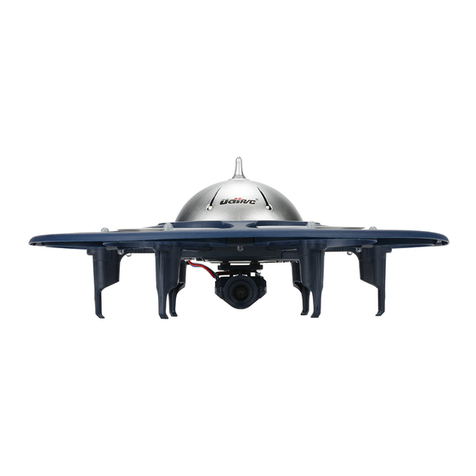
UDI R/C
UDI R/C VOYAGER U845Wifi user manual

Air Hogs
Air Hogs STAR WARS SPEEDER BIKE IMPERIAL ARATECH 74-Z Instruction guide
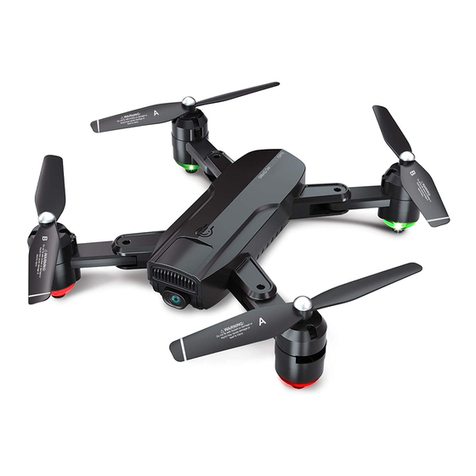
Dragon Touch
Dragon Touch DF01 user manual
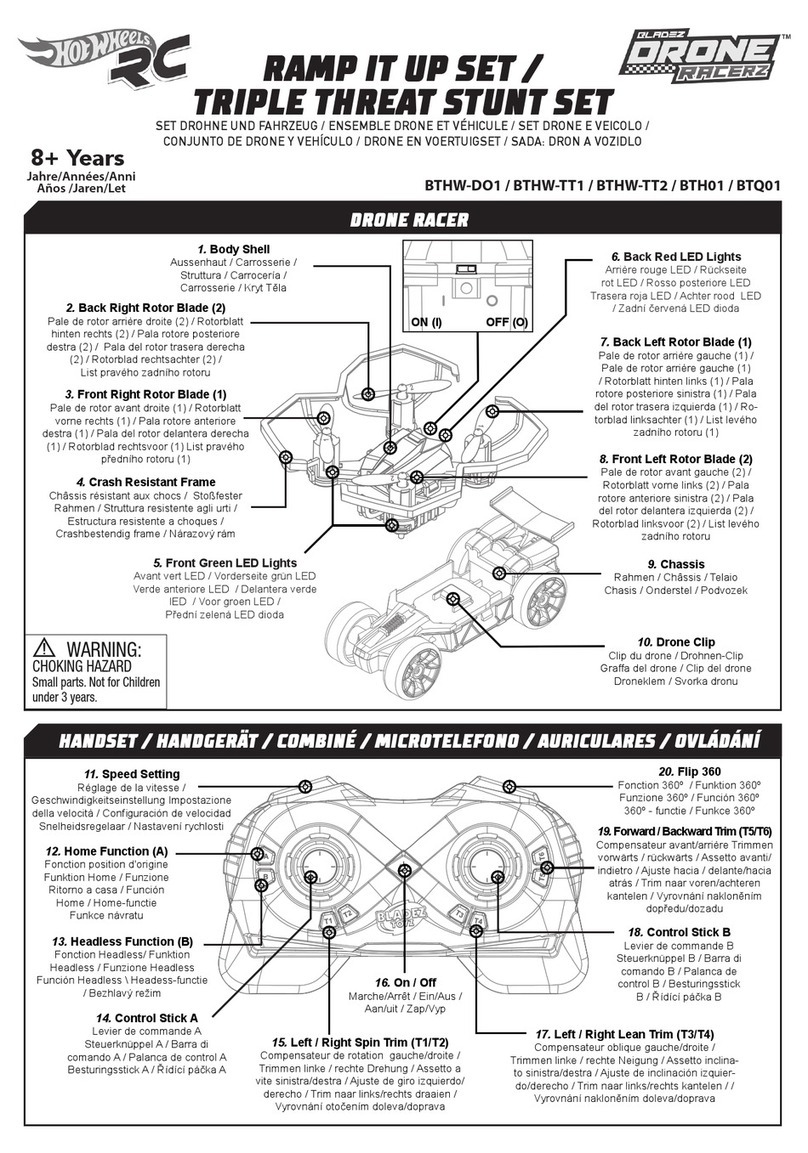
Hot Wheels
Hot Wheels RC BLADEZ DRONE RACERZ RAMP IT UP SET manual

Holystone
Holystone HS180 Instructions for use
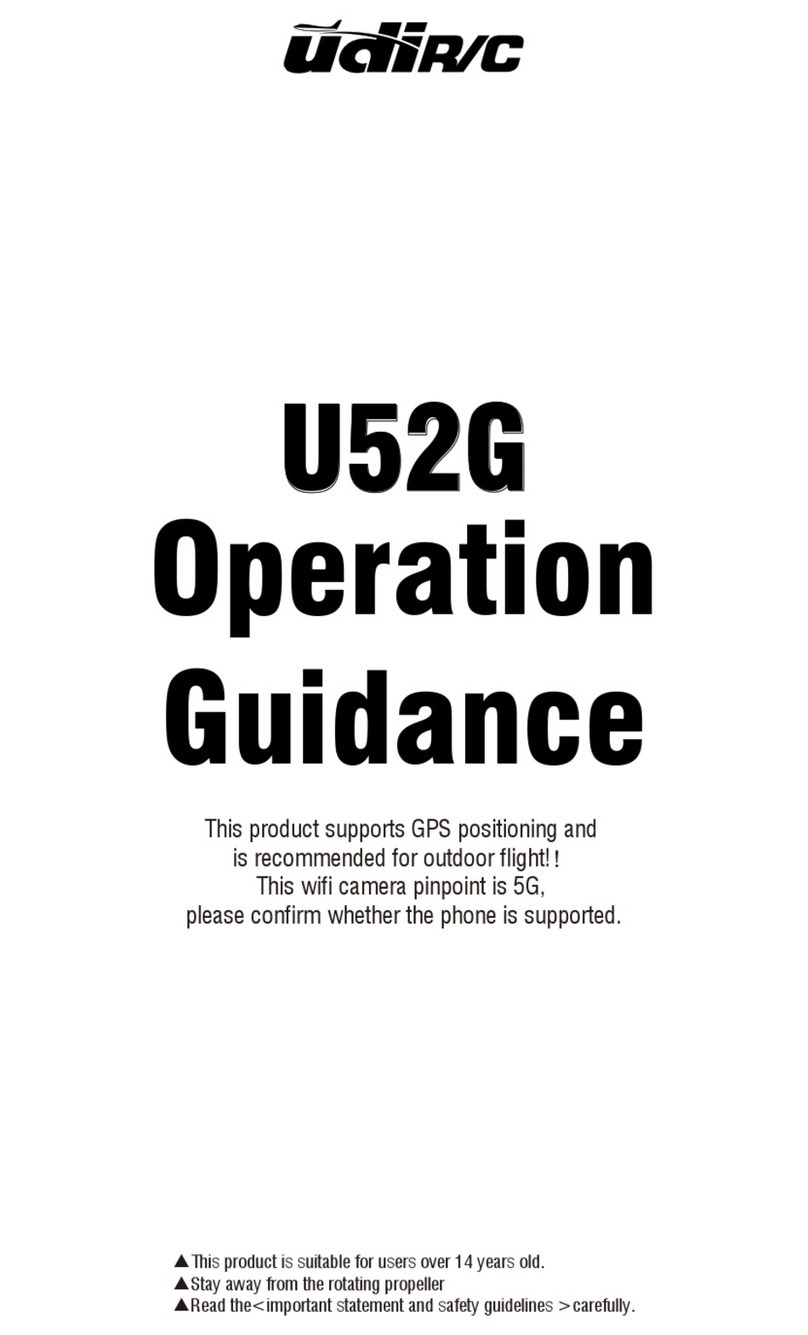
UDI R/C
UDI R/C U52G Operation Guidance
